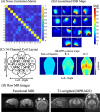This is a preprint.
An Open Access Resource for Marmoset Neuroscientific Apparatus
- PMID: 39605348
- PMCID: PMC11601486
- DOI: 10.1101/2024.11.12.623252
An Open Access Resource for Marmoset Neuroscientific Apparatus
Update in
-
An open access resource for marmoset neuroscientific apparatus.Imaging Neurosci (Camb). 2025 Feb 21;3:imag_a_00483. doi: 10.1162/imag_a_00483. eCollection 2025. Imaging Neurosci (Camb). 2025. PMID: 40800752 Free PMC article.
Abstract
The use of the common marmoset (Callithrix jacchus) for neuroscientific inquiry has grown precipitously over the past two decades. Despite windfalls of grant support from funding initiatives in North America, Europe, and Asia to model human brain diseases in the marmoset, marmoset-specific apparatus are of sparse availability from commercial vendors and thus are often developed and reside within individual laboratories. Through our collective research efforts, we have designed and vetted myriad designs for awake or anesthetized magnetic resonance imaging (MRI), positron emission tomography (PET), computed tomography (CT), as well as focused ultrasound (FUS), electrophysiology, optical imaging, surgery, and behavior in marmosets across the age-span. This resource makes these designs openly available, reducing the burden of de novo development across the marmoset field. The computer-aided-design (CAD) files are publicly available through the Marmoset Brain Connectome (MBC) resource (https://www.marmosetbrainconnectome.org/apparatus/) and include dozens of downloadable CAD assemblies, software and online calculators for marmoset neuroscience. In addition, we make available a variety of vetted touchscreen and task-based fMRI code and stimuli. Here, we highlight the online interface and the development and validation of a few yet unpublished resources: Software to automatically extract the head morphology of a marmoset from a CT and produce a 3D printable helmet for awake neuroimaging, and the design and validation of 8-channel and 14-channel receive arrays for imaging deep structures during anatomical and functional MRI.
Keywords: CT; Electrophysiology; MRI; Marmoset; Open Science; PET.
Figures







References
-
- Gilbert K. M. et al. Open-source hardware designs for MRI of mice, rats, and marmosets: Integrated animal holders and radiofrequency coils. J Neurosci Methods 312, 65–72 (2019). - PubMed
Publication types
Grants and funding
LinkOut - more resources
Full Text Sources
Miscellaneous
